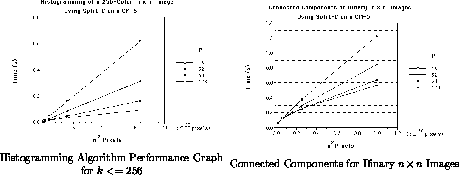


Next: Connected Components of
Up: Histogramming
Previous: Histogramming
The above analysis indicates that, for fixed p and k, the
communication complexity is independent of the problem size. Hence,
as n increases, we expect the local computation to dominate.
The histogramming algorithm has been implemented on a CM-5 with
p=16, 32, 64, and 128 processors, and the algorithm's
performance is plotted in Figure 3 for 256 grey
levels for images ranging from  to
to  pixels in size, and expanded in
Figures 12 - 14 for
pixels in size, and expanded in
Figures 12 - 14 for  to
to  images on 16, 32, and 64
processors. Corresponding performance graphs are given for the IBM
SP-1 in Figure 18 and for the IBM SP-2 in
Figure 20. Plots indicate quadratic performance
as a function of n for fixed p, and scalability in terms of p.
Hence, our theoretical analysis is supported.
images on 16, 32, and 64
processors. Corresponding performance graphs are given for the IBM
SP-1 in Figure 18 and for the IBM SP-2 in
Figure 20. Plots indicate quadratic performance
as a function of n for fixed p, and scalability in terms of p.
Hence, our theoretical analysis is supported.

Figure 3: Histogramming and Connected Components Scalability on the CM-5
Please refer to the plot in Figure 3 for an
illustration of the scalability of the histogramming algorithm's
performance. Since computation dominates for large n, the algorithm
runs as O . We have plotted
. We have plotted  vs. time for
four configurations of the CM-5. The resulting plot shows the linear
relationship between time and image size for each fixed p. Also,
when the number of processors double, the running time approximately
halves.
vs. time for
four configurations of the CM-5. The resulting plot shows the linear
relationship between time and image size for each fixed p. Also,
when the number of processors double, the running time approximately
halves.



Next: Connected Components of
Up: Histogramming
Previous: Histogramming
David A. Bader
dbader@umiacs.umd.edu
 to
to  pixels in size, and expanded in
Figures 12 - 14 for
pixels in size, and expanded in
Figures 12 - 14 for  to
to  images on 16, 32, and 64
processors. Corresponding performance graphs are given for the IBM
SP-1 in Figure 18 and for the IBM SP-2 in
Figure 20. Plots indicate quadratic performance
as a function of n for fixed p, and scalability in terms of p.
Hence, our theoretical analysis is supported.
images on 16, 32, and 64
processors. Corresponding performance graphs are given for the IBM
SP-1 in Figure 18 and for the IBM SP-2 in
Figure 20. Plots indicate quadratic performance
as a function of n for fixed p, and scalability in terms of p.
Hence, our theoretical analysis is supported.

 . We have plotted
. We have plotted  vs. time for
four configurations of the CM-5. The resulting plot shows the linear
relationship between time and image size for each fixed p. Also,
when the number of processors double, the running time approximately
halves.
vs. time for
four configurations of the CM-5. The resulting plot shows the linear
relationship between time and image size for each fixed p. Also,
when the number of processors double, the running time approximately
halves.